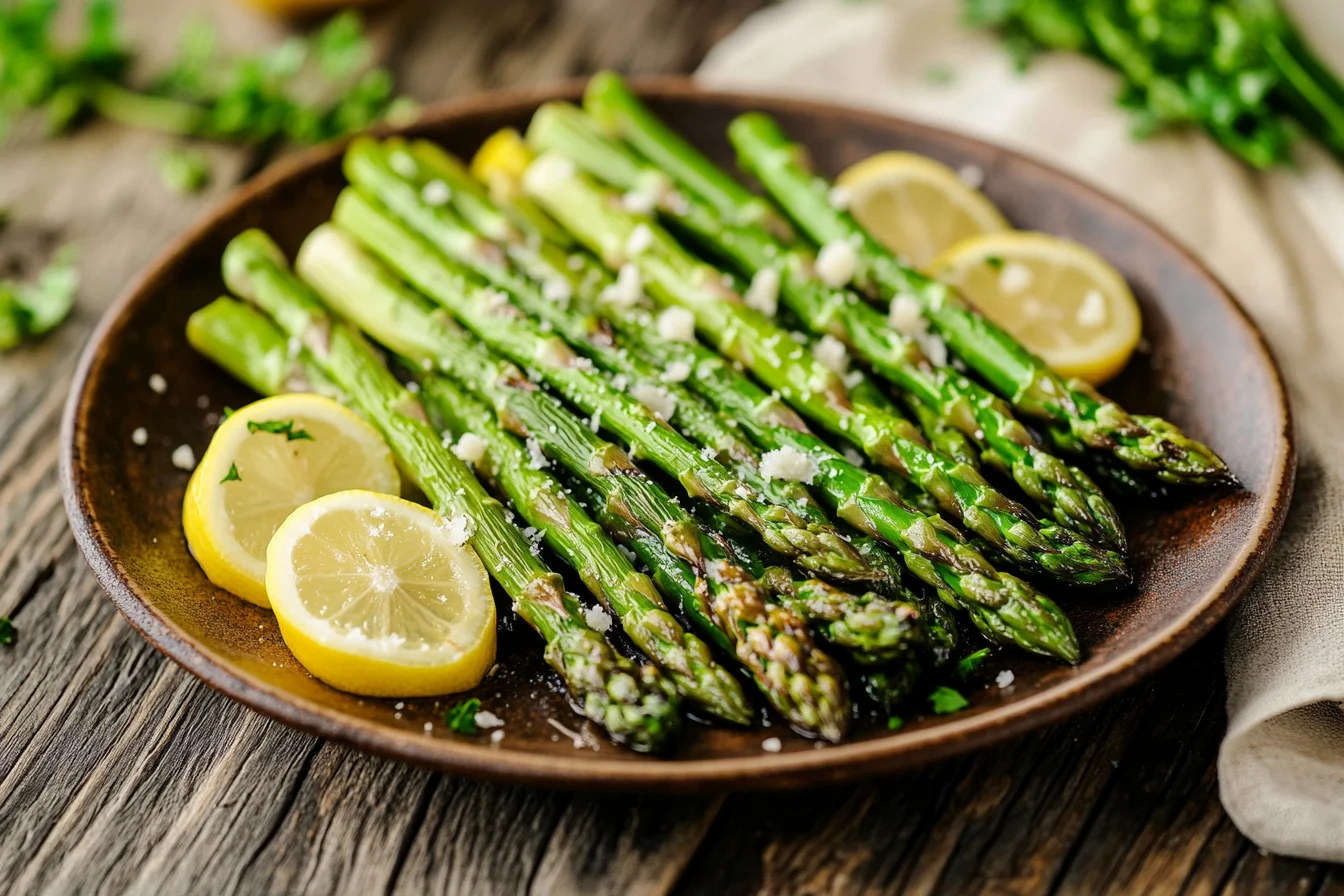How does Martha Stewart cook asparagus? Asparagus is one of those versatile vegetables that can be cooked in countless ways, roasted, sautéed, grilled, or even blanched. But when it comes to making the best asparagus, Martha Stewart is the go to expert. With her signature precision and culinary expertise, she has perfected multiple methods to achieve tender, flavorful spears every time.
In this guide, we’ll explore how Martha Stewart cooks asparagus, breaking down her tried and true techniques. From her classic oven roasted asparagus to expert tips on preventing mushy stems, you’ll learn the secrets to making asparagus just like Martha.
Let’s dive in.
Table of Contents
Martha Stewart’s Asparagus Cooking Techniques
Asparagus might seem easy to cook, but getting it just right, tender, slightly crisp, and full of flavor, requires some know how. Martha Stewart’s cooking methods elevate this simple vegetable into a gourmet side dish. Whether she’s roasting it at different temperatures, blanching it for freshness, or using a surprising trick for tough stems, her techniques guarantee the best results.
Why Martha Stewart’s Cooking Methods Stand Out
Martha Stewart’s approach to asparagus isn’t just about throwing it in the oven. She considers:
- The cooking temperature, which affects texture and caramelization.
- The preparation process, including cleaning and trimming.
- The seasonings and toppings that enhance flavor.
She balances simplicity with innovation, making her recipes easy to follow yet packed with professional level finesse.
The Importance of Cooking Asparagus Correctly
Poorly cooked asparagus can turn mushy, bland, or fibrous, far from the delicious, crisp tender bite it should have. Cooking it correctly preserves:
- Flavor – Enhancing its naturally grassy, slightly sweet notes.
- Texture – Keeping it firm yet tender.
- Nutrients – Retaining its vitamins and antioxidants.
With Martha Stewart’s expert techniques, you’ll never suffer from overcooked, limp asparagus again.
Martha Stewart’s Oven Roasted Asparagus Methods
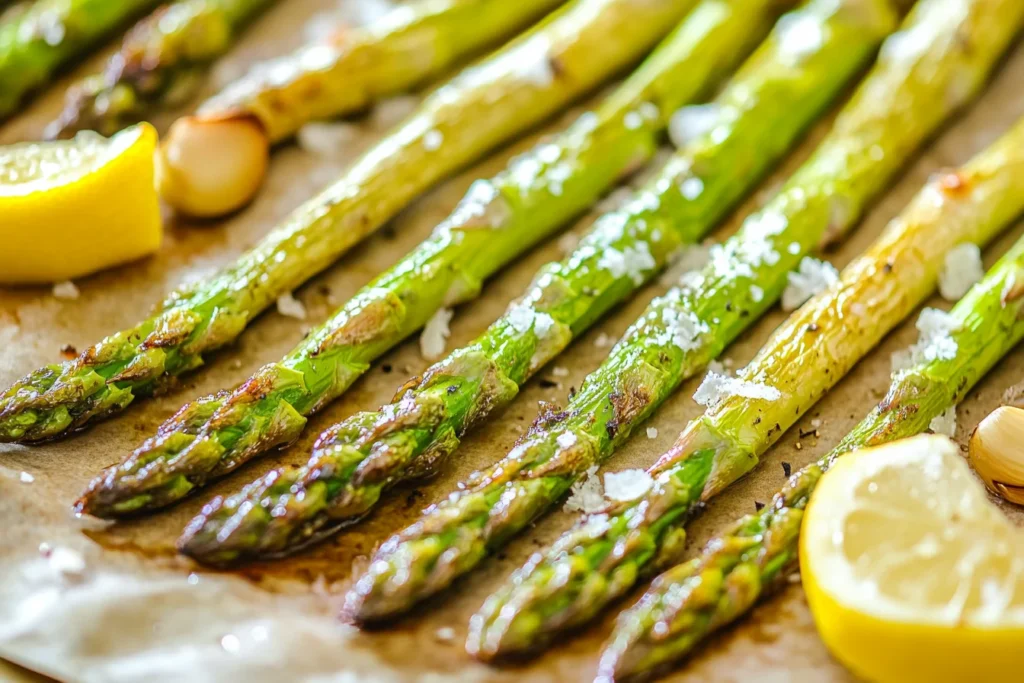
One of the most popular ways to cook asparagus is roasting it in the oven. Martha Stewart has shared multiple roasting techniques over the years, each designed to bring out the best flavors while maintaining the perfect texture. Whether she’s using a low and slow approach or a high heat roasting trick, her methods ensure asparagus turns out crisp tender and full of flavor.
Traditional Oven Roasting at 350°F
Martha Stewart’s classic oven roasting method is all about slow caramelization. By cooking asparagus at 350°F, she allows the natural sugars to develop, creating a slightly sweet, nutty taste.
How to Roast Asparagus at 350°F
- Preheat the oven to 350°F.
- Trim the tough ends off the asparagus spears.
- Toss them with olive oil, salt, and pepper.
- Arrange them evenly on a baking tray in a single layer.
- Roast for about 25 minutes, flipping halfway through.
This method is perfect if you want gentle caramelization without overcooking the spears.
High Temperature Roasting at 450°F: The Crispy Trick
For a more intense flavor and a slightly crispy texture, Martha Stewart recommends roasting asparagus at 450°F. This technique, featured in Simply Recipes and Yahoo Lifestyle, ensures the asparagus gets a nice char while remaining tender on the inside.
How to Roast Asparagus at 450°F
- Preheat the oven to 450°F.
- Prep the asparagus as usual (wash, trim, and season).
- Lay the spears on a baking sheet.
- Roast for 10–15 minutes, depending on thickness.
This method works great when paired with Parmesan cheese, Martha Stewart’s secret trick for adding a crispy, cheesy crust.
How to Achieve Perfect Caramelization
- Use a dark baking sheet to help conduct heat.
- Avoid crowding the pan, spread the spears evenly.
- Add a splash of lemon juice after roasting to brighten the flavors.
Best Seasonings and Toppings for Roasted Asparagus
Martha Stewart loves to experiment with seasonings. Here are some of her top choices:
- Garlic powder and crushed red pepper for a little kick.
- Parmesan cheese for a crispy topping.
- Balsamic glaze for a slightly tangy finish.
- Lemon zest to enhance the asparagus’ natural flavors.
By using these roasting techniques, you can cook asparagus just like Martha Stewart, perfectly golden, flavorful, and never soggy.
Other Cooking Techniques from Martha Stewart
While roasting is a go to method, Martha Stewart also prepares asparagus in several other delicious ways. Whether you’re looking for a quick stovetop method or a fresh, bright alternative, her recipes have you covered.
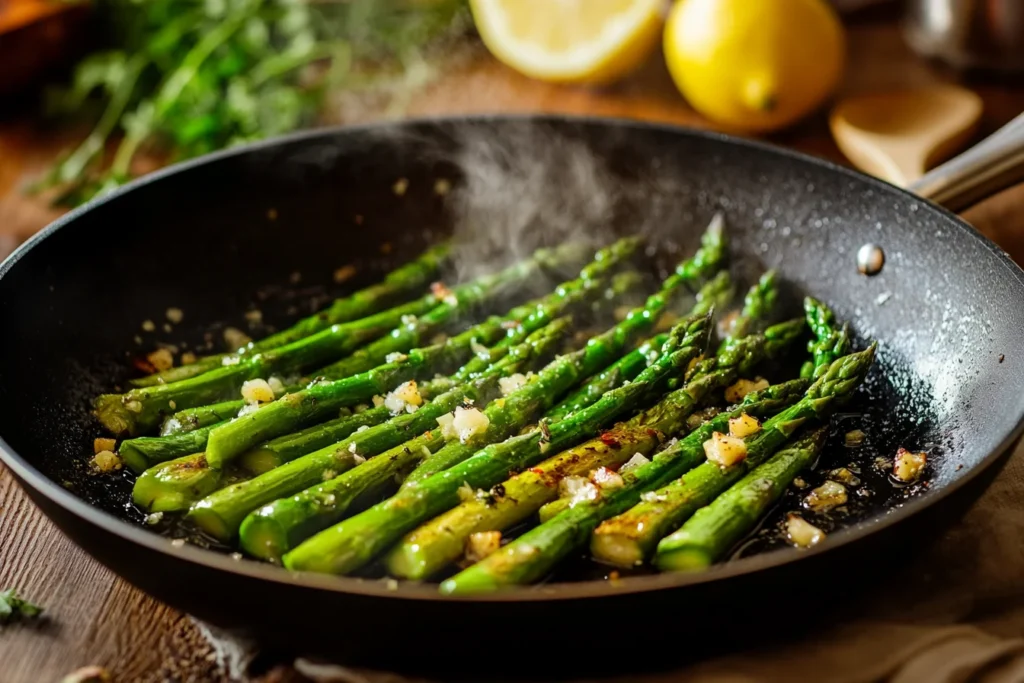
Sautéing Asparagus for a Quick, Flavorful Side Dish
Sautéing is a fantastic way to cook asparagus when you’re short on time. It takes just a few minutes, and the result is a tender yet slightly crispy texture.
Martha Stewart’s Sautéed Asparagus Recipe
- Warm olive oil or butter in a pan over medium heat.
- Place the trimmed asparagus in the pan and cook for 3–5 minutes, stirring from time to time.
- Sprinkle with salt and pepper, then finish with a squeeze of lemon juice.
- Finish with garlic or shallots for extra flavor.
Sautéed asparagus pairs well with steak, chicken, or pasta dishes.
Blanching and Steaming for Tender Yet Crunchy Spears
If you prefer a brighter, fresher taste, blanching or steaming is a great option. This method keeps asparagus crisp while enhancing its natural green color.
Blanching Asparagus
- Bring a pot of water to a boil and add salt.
- Add asparagus and cook for 2–3 minutes.
- Immediately place them in an ice bath to halt the cooking process.
Blanched asparagus works wonderfully in salads, pasta, or cold side dishes.
Steaming Asparagus
- Position the asparagus spears in a steamer basket above boiling water.
- Cover and steam for 5–7 minutes.
- Season with butter or olive oil before serving.
Steaming helps retain more nutrients, making it one of the healthiest ways to enjoy asparagus.
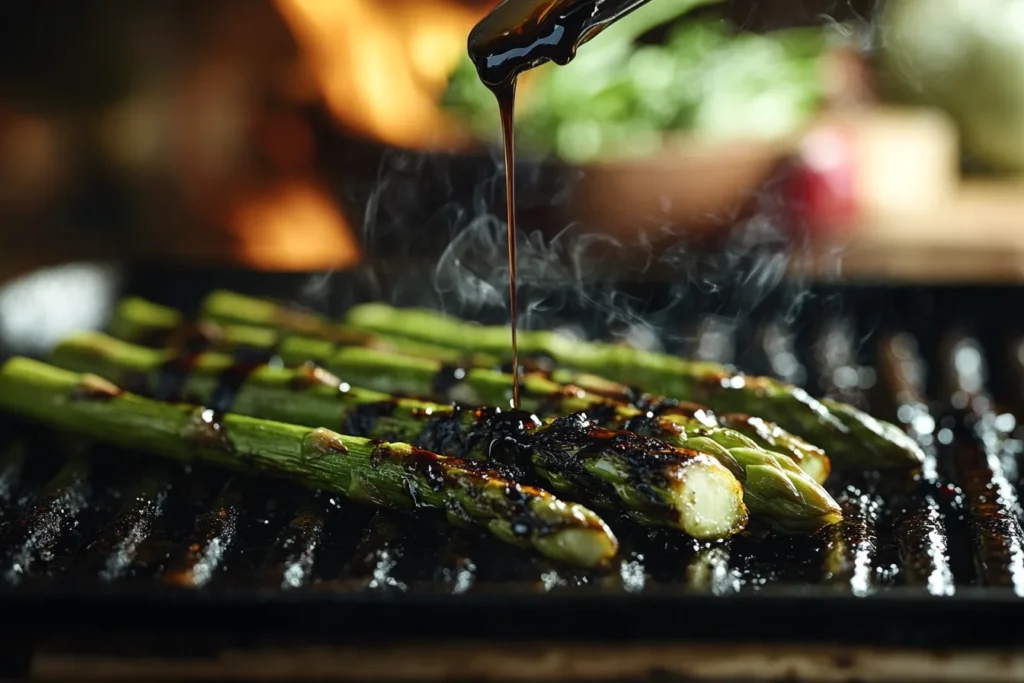
Grilled Asparagus: A Smoky Twist
Grilling asparagus brings out deep, smoky flavors while adding slight char marks. Martha Stewart often grills asparagus for a backyard barbecue or as a simple side dish.
How to Grill Asparagus Like Martha Stewart
- Preheat the grill to medium high heat.
- Toss asparagus with olive oil, salt, and pepper.
- Place spears directly on the grates and grill for 4–5 minutes, turning occasionally.
- Finish with balsamic glaze or Parmesan shavings.
Grilled asparagus complements grilled chicken, salmon, or steak perfectly.
Lemony Breadcrumbs for Added Crunch
One of Martha Stewart’s unique takes on asparagus is adding a crunchy topping. In her Roasted Asparagus with Lemony Breadcrumbs recipe, she elevates the dish with crispy, lemon infused breadcrumbs.
How to Make Lemony Breadcrumbs
- Toast panko breadcrumbs in a pan with butter and garlic.
- Add lemon zest and a pinch of salt.
- Sprinkle over roasted asparagus before serving.
This topping gives asparagus a delightful crunch and a hint of citrus, making it a restaurant worthy dish.
Martha Stewart’s Secret Tips for the Best Asparagus
If you’ve ever wondered how does Martha Stewart cook asparagus to perfection every time, you’re not alone. Beyond just roasting or steaming, she follows a few essential tricks to ensure the spears are always tender, vibrant, and packed with flavor.
The Trick to Making Tough Asparagus Stems Tender
Not all asparagus spears are created equal, some have woody, fibrous ends that can make them unpleasant to eat. Martha Stewart has a simple but effective trick to fix this:
- Snap or Trim the Ends – Hold the asparagus near the bottom and bend it gently. It will break naturally at the spot where the tough part starts. If you prefer, trim the spears with a knife instead.
- Peel the Stems – For thicker asparagus, use a vegetable peeler to remove the outer layer of the lower stalks. This helps them cook evenly and prevents any fibrous bites.
- Soak in Cold Water – Letting asparagus sit in cold water for 10–15 minutes before cooking can help make the stems extra tender.
How to Check for Asparagus Doneness
No one likes overcooked, mushy asparagus, and Martha Stewart has an easy way to tell when it’s done:
- Fork Test – Gently poke a spear with a fork. It should be tender but still firm.
- Color Check – Asparagus should turn bright green when perfectly cooked. If it starts looking dull, it’s likely overdone.
- Shake the Pan – When roasting or sautéing, give the pan a light shake. If the spears move easily and have a slight golden brown color, they’re ready.
The Rule You Should Never Break When Cooking Asparagus
Martha Stewart swears by one rule when cooking asparagus: Never overcook it. Overcooking leads to soggy, flavorless spears that lose their vibrant color and crisp texture. To prevent this:
- Always cook asparagus for the shortest time possible, you can always add more time, but you can’t undo overcooking.
- If steaming or blanching, remove the spears from heat and immediately shock them in ice water to preserve their crunch.
- When roasting, set a timer and check the asparagus at 10 minute intervals to avoid burning or drying out.
Martha Stewart’s Best Asparagus Recipes
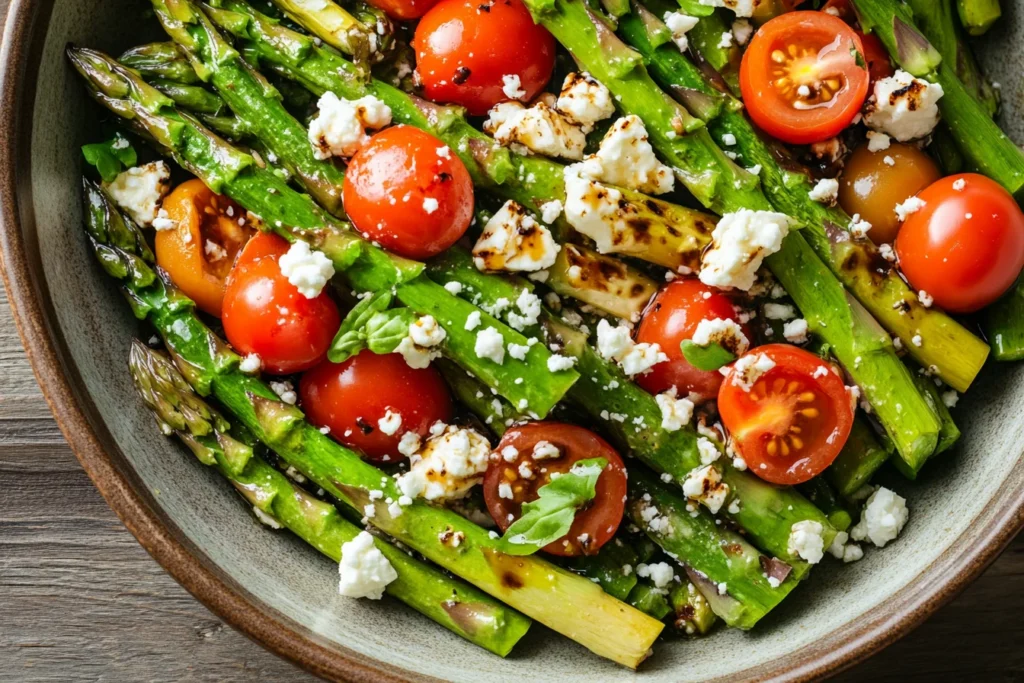
Now that you know the techniques, let’s talk about recipes! Martha Stewart has shared several asparagus dishes over the years, ranging from simple sides to elegant entrées. Whether you prefer roasted, grilled, or tossed in a salad, these recipes will help you get the most out of your asparagus.
Classic Roasted Asparagus Recipe
This signature Martha Stewart dish is the easiest and most foolproof way to cook asparagus. It’s great as a side for meats, seafood, or pasta.
Ingredients:
- 1 bunch of asparagus, trimmed
- 2 tbsp olive oil
- ½ tsp salt
- ½ tsp black pepper
- 1 tbsp Parmesan cheese (optional)
Instructions:
- Preheat the oven to 425°F.
- Place the asparagus on a baking sheet and toss with olive oil, salt, and pepper.
- Spread them out in an even layer, no overlapping.
- Roast for 12–15 minutes, flipping halfway through.
- Sprinkle Parmesan cheese over the top (optional) and serve immediately.
Asparagus Salad and Side Dish Ideas
If you’re looking for lighter options, Martha Stewart has asparagus based salads and side dishes that highlight its freshness.
- Asparagus with Lemon Vinaigrette – Blanch asparagus and toss it with olive oil, lemon juice, Dijon mustard, and a pinch of sea salt.
- Asparagus and Feta Salad – Mix roasted asparagus with crumbled feta cheese, cherry tomatoes, and balsamic glaze for a refreshing side.
- Chilled Asparagus with Yogurt Dressing – Blanch and chill asparagus, then drizzle with Greek yogurt mixed with garlic, dill, and lemon zest.
Creative Asparagus Dishes for Spring
Martha Stewart often includes asparagus in more creative dishes, perfect for spring gatherings.
- Asparagus and Ricotta Tart – A flaky puff pastry base topped with creamy ricotta and roasted asparagus spears.
- Spring Asparagus Risotto – Creamy arborio rice infused with asparagus, garlic, and Parmesan.
- Asparagus Soup – A smooth, velvety soup made with pureed asparagus, broth, and a hint of cream.
Nutritional Value of Asparagus (Per 100g)
Asparagus is a low calorie, nutrient rich vegetable packed with vitamins, minerals, and antioxidants. Below is the nutritional content per 100 grams of raw asparagus:
| Nutrient | Amount |
|---|---|
| Calories | 20 kcal |
| Carbohydrates | 3.9 g |
| Protein | 2.2 g |
| Fat | 0.2 g |
| Fiber | 2.1 g |
| Vitamin C | 5.6 mg (9% DV) |
| Vitamin A | 756 IU (15% DV) |
| Vitamin K | 41.6 mcg (52% DV) |
| Folate | 52 mcg (13% DV) |
| Iron | 2.1 mg (12% DV) |
| Calcium | 24 mg (2% DV) |
| Magnesium | 14 mg (4% DV) |
| Potassium | 202 mg (6% DV) |
Asparagus is an excellent source of fiber, folate, vitamin K, and antioxidants, making it a great addition to a healthy diet. Whether roasted, grilled, or steamed, this vegetable is not only delicious but also highly nutritious.
Frequently Asked Questions (FAQs)
What is Martha Stewart’s trick for roasting asparagus?
Martha Stewart has shared multiple roasting tricks, but her most famous one involves using high heat for maximum caramelization. She recommends:
- Preheating the oven to 450°F.
- Tossing the asparagus with olive oil, salt, and pepper.
- Spreading the spears evenly on a baking sheet, no overcrowding.
- Roasting for 10–15 minutes, flipping halfway.
She also suggests sprinkling Parmesan cheese during the last few minutes of roasting for extra flavor and crispiness.
Should I peel asparagus before cooking?
It depends on the thickness of the spears. Martha Stewart often peels thicker asparagus to remove the fibrous outer layer, ensuring a more tender bite. If your asparagus is thin and fresh, peeling isn’t necessary. Instead, simply snap off the woody ends before cooking.
How do you keep asparagus from getting mushy?
Mushy asparagus is usually a result of overcooking or steaming for too long. To avoid this:
- Roast or grill instead of boiling.
- If steaming or blanching, shock the spears in ice water immediately after cooking.
- Keep cooking times short and precise, asparagus should be tender but still have a slight bite.
What is the best temperature for roasting asparagus?
Martha Stewart recommends two roasting temperatures depending on the desired texture:
- 350°F for a slower roast with gentle caramelization (about 25 minutes).
- 450°F for a crispier texture and deep flavor (about 10–15 minutes).
Both methods work well, but if you love a slight crunch, go with high heat.
If you’re looking for more ways to enjoy asparagus, you might love trying a warm and comforting Asparagus Soup Recipe. This dish transforms fresh asparagus into a creamy, flavorful soup that’s perfect for any season. Additionally, if you want a nutritious side dish to pair with your asparagus, check out this Broccoli Cauliflower Salad Recipe, which offers a crunchy, refreshing contrast to roasted or grilled asparagus. Whether you’re following Martha Stewart’s techniques or exploring new recipes, these dishes will complement your asparagus perfectly.
conclusion
Martha Stewart’s asparagus cooking methods focus on enhancing flavor and maintaining the perfect texture. She recommends roasting at either 350°F for gentle caramelization or 450°F for a crispier bite, as well as sautéing, steaming, blanching, or grilling for different results. Her top tips include trimming woody ends, using high heat for roasting, avoiding overcooking, and adding creative seasonings like Parmesan, lemon zest, or balsamic glaze. Popular recipes include classic roasted asparagus, asparagus salad with feta, and creamy asparagus soup.
